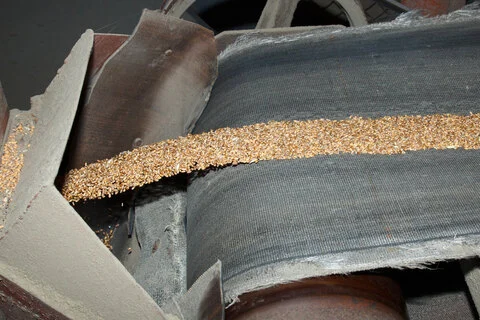Textile Conveyor Belt Standards

Textile conveyor belt standards address the additional tests that conveyor belts with a textile composition undergo. Flammability, tear propagation, tensile strength, and dimensional tests are included. Additionally, specifications for rubber or plastics covered belts of textile construction are given, addressing both general and underground mining, anticipating the range of environments conveyor belts with a textile carcass will be used in.
ISO 16851:2012
Textile conveyor belts - Determination of the net length of an endless (spliced) conveyor belt
ISO 16851:2012 specifies a method for determining the net length of an endless (spliced) conveyor belt. It applies to all types of construction of conveyor belting with the exception of belts containing steel cord reinforcement. It is not suitable or valid for light conveyor belts described in ISO 21183-1.
ISO 283:2015
Textile conveyor belts - Full thickness tensile strength, elongation at break and elongation at the reference load - Test method
ISO 283:2015 specifies a test method for the determination of the full thickness tensile strength in the longitudinal direction and the elongation at the reference force and breaking point of conveyor belts having a textile carcass. The method can also be used for the determination of full thickness tensile strength in the transverse direction and the elongation at the breaking point, for use when the manufacturer is requested by the purchaser to state values for these properties. ISO 283:2015 is not suitable or valid for light conveyor belts as described in ISO 21183 1.
ISO 14890:2013
Conveyor belts - Specification for rubber- or plastics-covered conveyor belts of textile construction for general use
ISO 14890:2013 specifies requirements for rubber and/or plastics covered conveyor belting of textile construction for general surface use on flat or troughed idlers. ISO 14890:2013 is not suitable or valid for light conveyor belts as described in ISO 21183-1. Items that are not requirements of ISO 14890:2013, but need to be agreed between the manufacturer and the purchaser, as well as a list of the details intended to be supplied by the purchaser of belting with an enquiry are included in the annexes.
ISO 22721:2007
Conveyor belts - Specification for rubber- or plastics-covered conveyor belts of textile construction for underground mining
ISO 22721:2007 specifies requirements for rubber- or plastics-covered conveyor belting of textile construction for underground mining on flat or troughed idlers. It is not applicable to light conveyor belts as described in ISO 21183 1. ISO 22721:2007 does not include requirements for plastics covers.
ISO 340:2013
Conveyor belts - Laboratory scale flammability characteristics - Requirements and test method
ISO 340:2013 specifies a method for assessing, on a small scale, the reaction of a conveyor belt to an ignition flame source. It is applicable to conveyor belts having a textile carcass as well as steel cord conveyor belts.
ISO 3870:1976
Conveyor belts (fabric carcass), with length between pulley centres up to 300 m, for loose bulk materials - Adjustment of take-up device
Describes fixed and automatic take-up devices. Contains recommendations for adjustment values which are valid for the most commonly used belts. Tabulates various types of take-up devices with relation to conveyor lengths from 0 to 12 m up to 150 to 300 m. For belts with a fabric carcase whose length exceeds 300 m and belts with a metal carcase of any length, the manufacturer should justify the chosen adjustment.
ISO 505:2017
Conveyor belts - Method for the determination of the tear propagation resistance of textile conveyor belts
ISO 505:2017 specifies a method of test for the measurement of the propagation resistance of an initial tear in textile conveyor belts, either in full thickness or of the carcass only. This test is intended for application to textile belts in installations where there is a risk of longitudinal tearing.
ISO 583:2007
Conveyor belts with a textile carcass - Total belt thickness and thickness of constitutive elements - Test methods
ISO 583:2007 specifies test methods for the determination of total belt thickness and the thickness of constitutive elements of conveyor belts having a textile carcass. The constitutive elements include the covers, the carcass and interlayers, i.e. the material between adjoining plies. It is not suitable or valid for light conveyor belts as described in ISO 21183-1.





